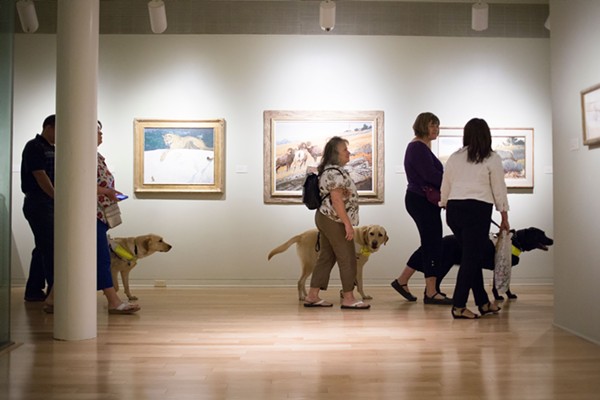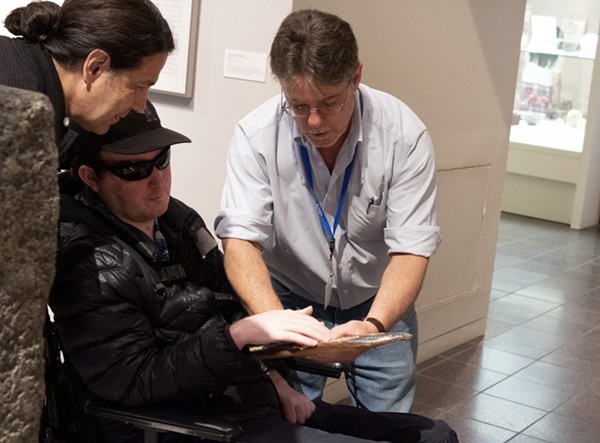- Courtesy San Antonio Museum of Art
- Visitors with visual impairments explore the museum with their guide dogs.
Visitors to the San Antonio Museum of Art can appreciate ancient pottery, modern American paintings and massive marble sculptures – all without ever seeing them.
SAMA began developing tours for the blind and visually impaired in 2014, after a chance encounter between a SAMA docent and an active member of the blind community left the museum pondering the best way to present visual art to people with visual impairments.
Mary Hogan, a SAMA docent who leads tours for the visually impaired, said the tours focus on a theme and tend not to rove around the museum too much, since it is important to consider the visitors’ mobility.
“We have given really elaborate tours on death, life and religion, and we have given tours about women, and there have been esoteric tours where we’ve gone all over the museum,” Hogan said. “However, we’ve learned that we really need to limit our tours to a theme.”
Hogan said the tours usually start with a piece of music to introduce visitors to the theme and the first piece. Then the docent will use descriptive language to help visitors visualize the piece of art or artifact being presented.
“You have to say, ‘This is a painting,'” Hogan said. “And you have to say, ‘This is a sculpture, and it is 15 feet high and about 6 feet wide.’ And that’s not something you would do to normal sighted tours. But you have to be a little more precise in what you say.”
Hogan said visitors can touch replicas of the artwork, created by SAMA interns specifically for these tours. Additionally, docents use props they picked up from antique stores and garage sales to give more texture, weight and size to the objects being discussed. So, if a fine, ancient vase is the art piece in question, visitors can feel the shape of a prop vase.
“We have props that our clients can feel and touch and explore. Sometimes we have scents, different smells that go with that object, and some docents share some poetry,” Hogan said. “We don’t do all of these multisensory things with each picture, painting or artifact that we present. Sometimes we do all of them, and sometimes we just do two or three.”
- Courtesy San Antonio Museum of Art
- A docent lets a visitor touch a facsimile of the artwork to form a better picture of the piece.
Hogan said docents are required to undergo some informal training to learn how to use descriptive language, and that SAMA is the only San Antonio art museum to offer this type of program.
Franklin Jones has been attending these tours for the past three years, and said SAMA is the only art museum in the city he visits.
“We don’t go to the other museums, given the fact that I can’t appreciate it,” said Franklin, who has macular degeneration. “We didn’t get the same feeling of preparation from docents at the other museums.”
Franklin said the SAMA docents go to great lengths to give background information on the piece and the artist who created it, as well as their other works. Vials of scents, music clips, tactile materials like marble or limestone and sidebar anecdotes from docents give visitors with visual impairments a complete picture of the artwork. Jones said this totality of context is quite different from what may be offered on tours for sighted people.
“There is a difference between being able to see something and having a vision of something,” Franklin said.
Franklin’s wife Veronica Jones accompanies him on these tours and said the music pieces are particularly helpful in illustrating the mood or background of a piece. She said the docents played Mariah Carey’s “When a Hero Comes Along” to introduce a piece created by a black artist, which brought him to life.
“It’s incredible the way he was stepping out,” Veronica said.
The Joneses also noted that the tours are beneficial for people who may be shut in or cut off socially because of their visual impairment. They said the tour-goers’ ages range from young Millennials to mid-70s. “We’re probably the oldest people there,” Franklin said, smiling.
SAMA offers these free tours each first Saturday of the month.














